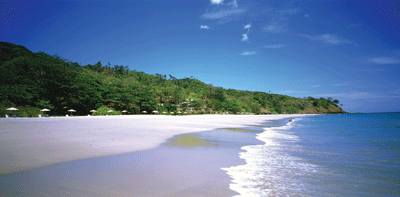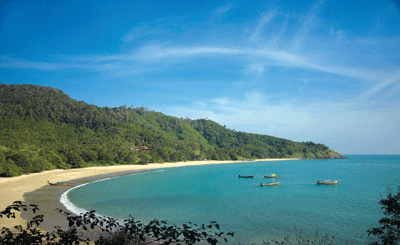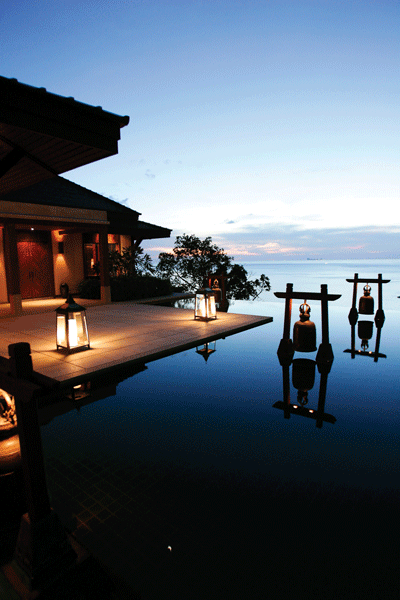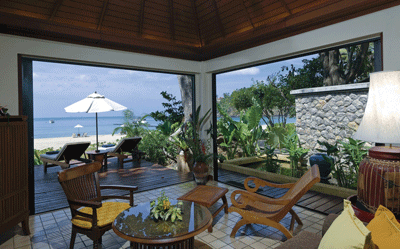When I daydream about Thailand’s tropical islands, I’m aboard a long-tail boat skimming towards a palm-fringed beach, alternating my gaze between a sea that’s the deepest blue to the lush coastline that’s rapidly approaching. A glance at the water and it imperceptibly travels through the whole gamut of blue to become so clear that it’s easy to spot the tropical fish and see the colourful coral below as the boat slows to a halt in the shallows. I hop off to squeak my way up the snow-white sand to a beach hut nestled under the palms. If this sounds hopelessly idyllic, it’s how I first experienced Koh Samui back in the early 90s.
However, contemporary life on most of Thailand’s islands is more about the ugly hotel blocks that have replaced the beach huts, and about fast food joints, traffic jams and thousands of package tourists with little interest in the local culture, who are more inclined to be in search of the tawdry attractions of the nearest go-go bars or buying fake handbags. The beaches have fared little better, blighted by rows of sun loungers and piles of rubbish, while the once crystal clear waters are slowly polluted and the coral reefs destroyed by the barrage of dangerous jet skis, banana boats and paragliders’ speedboats.

Unfortunately, the lure of the tourist dollar seems to have proved too strong for many islands recently, so it was with a good deal of trepidation that I set off for Koh Lanta Yai (the larger of the two Koh Lanta islands), located in Krabi Province in Thailand’s far south. These islands are just a couple of hours from the tourist debacle that Phuket has become. The first thing that’s noticeable on arrival in Saladan in north Koh Lanta is the lack of high-rise buildings.
Jumping aboard a motorbike and sidecar, the preferred mode of transport, and heading south, it’s quickly apparent that the further you go the quieter it becomes. There are enormous stretches of beachfront that are completely and magnificently undeveloped.
The range of accommodation on this 340sqkm island ranges from simple beach huts to large resorts but, even at the top end, the villas blend seamlessly into the island’s richly forested mountainous topography or are placed on headlands overlooking deserted beaches and the inviting waters of the Andaman Sea. In fact, you’ll be hard pushed to find a building higher than three floors anywhere on the island.
Construction is taking place, but thankfully with a more wholistice vew, keeping with the island’s ambiance. New resorts are targeting visitors looking for yoga or health retreats, while private developments are limited to no higher than the indigenous palm trees.

Take a walk along any of the nine glorious beaches on the 27km-long west coast (the east coast is mainly covered by mangrove forests so there’s little in the way of accommodation) and it’s glaringly obvious that there are simply not many tourists here. An added bonus is that no watercraft are visible apart from the occasional dive boat or fishing vessel bobbing on the turquoise sea.
The island’s community has worked tirelessly to maintain its traditional way of life. Koh Lanta is home to three distinct groups – the Chao Ley (Sea Gypsies), the Thai Muslims and the Thai Chinese, who have lived in mixed communities for centuries. This cultural fusion gives the island a feel that’s more akin to nearby Indonesia or Malaysia.
The best place on the island to witness this unique blend of peoples (and sample the wonderful food) is in the Old Town on the east coast, formerly a port of call for Chinese and Arab traders for hundreds of years. A walk along the main street reveals old, dark wooden warehouses and stilt-house stores built over the water. Some of these served as opium dens as late as the 1950s and have now been converted into restaurants and tourist shops while maintaining the buildings’ architectural integrity and the town’s historical appeal.
This exotic mix of cultures is transmitted into the local cuisine and lovers of Thai food won’t be disappointed. Due to its strategic point on the spice trade route, this place really was a melting pot of beliefs, ideas and even recipes. The deliciously creamy and spicy massaman curry hails from this part of Thailand. The name of the dish itself allegedly derives from the word musalman, an archaic synonym for Muslim. In fact, perusing the list of ingredients required for the dish is like reading an abridged version of the spice trade: chilli, cumin, coriander, cardamom, cinnamon, nutmeg, mace, cloves, ginger, turmeric, coconut, palm sugar, lemongrass and tamarind.
As a port of call on this valuable trading route, the islands of the Andaman sea would have seen traders from Portugal, the Middle East and China, trading between ports in India, Indonesia and Malaysia to as far away as Europe.
Dishes such as the massaman curry are now commonplace on Thai menus the world over, but in southern Thailand it’s more likely to be served with rotis and ajaat, (a slightly pickled cucumber salad) than plain white rice.
Another more common Thai dish that serves as the perfect foil to a spicy curry is som tam (green papaya salad). This delightfully refreshing salad is also readily available everywhere on the island. Koh Lanta obviously has a huge amount of seafood on offer, but if you’re like me, you might be more interested in viewing these beautiful creatures alive and in their natural habitat.
Koh Lanta is probably best known as a great destination from which to explore the beautiful reefs and stunning outlying limestone islands in the vicinity for the variety of diving that’s on offer.
Whether you like diving with large pelagic fish, vivid fan corals or seeing “Nemo”-like reef fish, diving here is of the highest quality and the range of sites (the Koh Lanta archipelago is made up of over 50 small islands) will leave you spoilt for choice.
Live-aboard dive trips expand the selection even further afield, with trips west to India’s nearby Andaman Islands or north to the rugged coastline of Myanmar.
If you’re in Koh Lanta between February and May, you’ll get the chance to see the world’s largest living fish species, the hugely impressive (and non-human eating) whale shark, as well as local residents, leopard sharks and manta rays, that will not disappoint any diving enthusiast.
I’ve been back to Thailand regularly since my first visit and it’s incredibly refreshing to visit Koh Lanta and find an island that has all the allure, the serenity, the natural beauty and simplicity of life that first attracted me to Thailand nearly two decades ago.
This is truly a place where you can kick back and relax, enjoy a cool drink and watch a perfect sunset.
Here you can experience a myriad of activities including elephant trekking, peaceful boat trips to nearby uninhabited islands, sea kayaking or trekking and exploring the lush 134sqkm national park. But above all, here there’s a genuine smile on the faces of the locals, and for all this, the island’s inhabitants have to be congratulated.

FACT FILE
Getting there: There are two routes to Koh Lanta from the nearest international airports if you want to bypass travelling through Bangkok. If you are coming through the larger of the two airports located at the northern end of Phuket, take a taxi to the ferry port located near the sea gypsy village on the island’s southeast. From here, take a boat to Koh Lanta.
After one and a half hours, passengers will need to change boats at sea and climb aboard the Phi Phi to Lanta ferry.
The transit is very smooth and offers exquisite views of the stunning limestone cliffs and caves of the Phi Phi Islands. This small group is made up of six islands, best known are Phi Phi Leh, where in 2000 the Leonardo di Caprio film, The Beach was set, and Phi Phi Don, which was an idyllic tropical island escape until it was devastated by the 2004 tsunami.
From here, it’s one more hour to the ferry terminal at Saladan at the northern tip of Koh Lanta.
The other option for visitors is to fly to Krabi International Airport, located on the mainland. From here, it’s a less than two-hour taxi ride that involves taking two passenger ferries. The first is from the mainland to Koh Lanta Noi, which takes about 20 minutes, then there’s another smaller one from Lanta Noi to Lanta Yai which takes about five minutes.
The drive from the airport allows great views of the region’s verdant and tropical flora, as the road dissects palm groves and rubber plantations, while the roadside villages bloom with vibrant bougainvillea, frangipani and hibiscus.
The views from the ferry show the island’s contrasts, as the eastern side of Koh Lanta differs sharply from the west.
While the west coast has crystal clear water and white sand beaches, the east coast consists of dense green jungle that seems to stretch right down to the thick mangrove forests that inhabit the water line. The sea is a deep, dark blue.
There are several other ways to access the island, as there’s a domestic airport at Trang, which also has a station on the train line that links Bangkok to Kuala Lumpur.

Where to stay: Pimalai Resort & Spa, which opened in 2001, is located on the hillside above picturesque BaKan Tiang beach, offering 121 accommodation in different styles from deluxe rooms to beachfront villas.
Rates start from US$300. Visit www.pimalai.com for more information.








